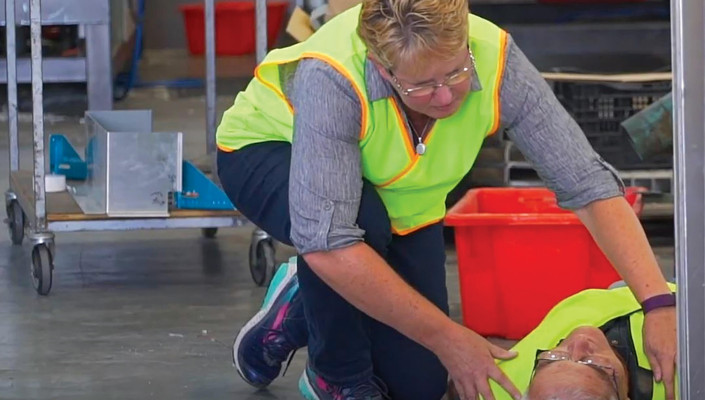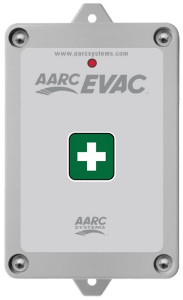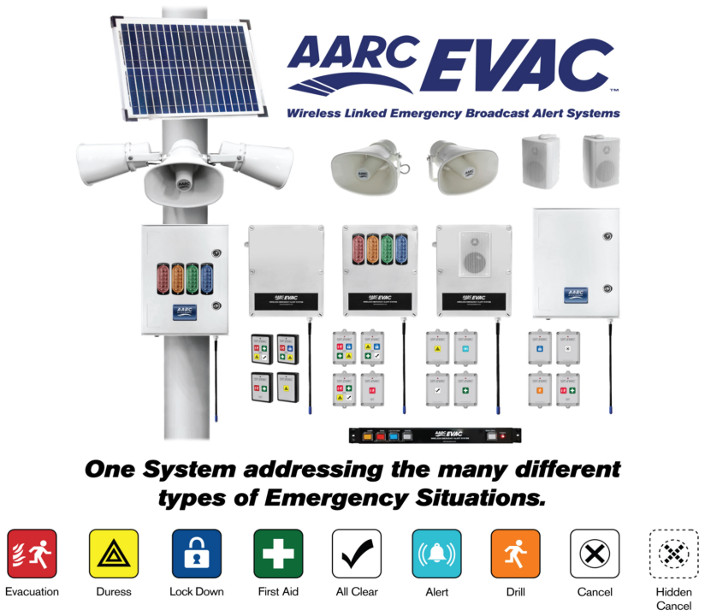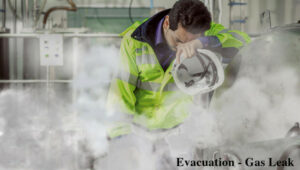A First-Aid System to “Reduce the Time to First Response”

Potentially Providing Significant Improvements to Workplace and other Medical Emergency Outcomes!
Medical emergencies in the workplace typically result from Accidents, or Personal Medical Incidents. It is well known that in many cases of workplace injury, or Personal Medical Incidents, that:
“The Time to First Response, by a qualified First Aider or Medical Professional, can have a Significant Impact on the Outcome of a Medical Emergency”
Workplace Occupational Health & Safety (OH&S) has had a major focus on accident prevention and worker wellbeing. In recent times, even with the development of Artificial Intelligence (AI) now being used in some SME workplaces, replacing highrisk jobs and some menial tasks with high-cost through to low-cost robotics.
Workplace accidents still happen, and personal medical incidents will always continue to happen!
Improvement to Workplace Medical Emergency Outcomes through a reduction in the “Time to First Response by a qualified First Aider” is not strictly a preventative measure; however, it can significantly affect the severity of the outcome of an injury, or Personal Medical Incident. This can flow on to significant improvements in post incident quality of life for the impacted worker/s, a reduction in return-to work times, if needed at all, and the removal of or reduction in the potential of associated mental health and wellbeing issues.
Economically: In the case of an injury, it also has the potential to reduce loss of productivity, workers compensation and accident investigation cost, return to work management costs, management Duty of Care issues and more.
How do we “Reduce the Time to First Response”?
An Australian company, AARC Systems recognized the need for a solution. After some extensive investigation it found that to “Reduce the Time to First Response” would require the design and development of a suitable product or system.
The following list of overall system design requirements was developed.
Level 1.
- A system needs to be Robust, work when needed and work every time!
- A system needs to be effective in meeting the goal of reducing the time to first response.
- Any Equipment itself needs to be affordable and needs to be cost effective to install, particularly when retrofitting to an existing building/s or an existing site.
- A system needs to support several distinct unique locations with call points for First Aid, these locations should be based on a risk assessment that meets the needs of the organization.
- A system needs to be flexible to suit the needs of the organization, large or small.
Based on these requirements, considerable consultation and consideration was given to the design engineering of a system that would meet every one of these requirements and more. Indeed, many of the design outcomes would need to meet multiple requirements.
The Outcomes
Based on the Level 1 design requirements coupled with the injection of Australian innovation, a system structure and specification was developed utilising a RadioControlled (RC) Network, with a unique data protocol, to be developed for emergency application.
- A unique data code for each individual system and a unique data code to identify each individual call location. – Robust
- Eliminating the need for nearly all hard wiring, this is particularly desirable when retrofitting a system to an existing site, (which can be prohibitively expensive). – Affordable & Cost Effective
- Eliminating potential damage to or connectivity issues with hard wired systems. These can cause redundancy concerns and significantly affect the robustness of such systems. – Robust
- Ability to support multiple “call for assistance” locations using battery powered RC emergency push button transmitters. – Multiple Call Locations – Affordable & Cost Effective – Robust
- Ability to extend the Radio-Controlled (RC) Network to supply other functionality within any unique system. This could add coverage for OVA/Duress Assist, Evacuation, Lockdown, and other unique alarms. Spreading the system cost, across other functionalities. – Affordable & Cost Effective
What components would be needed to build a FirstAid Assist System?
To complete a Radio-Controlled (RC) “First-Aid Assist” system, would firstly, require use of the following:
-
“Call to Location”, First Aid emergency push button transmitters, would need to be battery operated, without needing any external wiring, so as to aid their placement across a site.
-
At least one “Call to Location”, First Aid emergency push button RC transmitter would be required, or
-
Multiple “Call to Location” transmitters would be required to be distributed at locations across a site.

Each system would need, at a minimum, one of the following options:
- A unit with an output suitable for input into an existing Public Address (PA) system. This would require to be fitted with a multiple channel Radio controlled switch, and a digital message player. It would also need to be able to transmit to the network using panel mounted push button switches, on the PA interface unit.
- At least one autonomous unit would be required, fitted with a multiple channel Radio controlled switch, a digital message player, an audio amplifier or multiple audio amplifiers and each unit would require its own UPS Battery Back-up system. The unit should also have the option of including a flashing beacon.
These units would need to come in a variety of versions, including indoor units, outdoor units and solar powered outdoor units. - A network of multiple autonomous self-contained RC units as described above.
- A combination of a Public Address (PA) system unit and one or more multiple autonomous self-contained RC units as described above. The autonomous units filling in the areas not covered by the PA system.
For all systems using autonomous receiver-message player units, each system will require the use of loud speakers.
- Load speakers would be needed to deliver the sirens and voice instructions.
- The loud speakers would need to be high efficiency loud speakers and would need to include ceiling, box and horn speakers, as appropriate to environment where they would be located.
All the individual components would need to be designed to work together, allowing a system to be designed to meet the exact needs of the customer.
Great News:
AARC Systems has now produced the AARC EVAC, a product based system which meets all of the above requirements and more. The system is now in the market, and has been extremely successful in satisfying customer expectations.
AARC has already delivered multiple systems to all of the following sectors:
Education – from Pre-Schools to TAFE colleges, Industry, Mining, Ports, Local Government, Health and Disability Services, Retail, Warehousing, a range of Sports & Leisure venues, Construction, Tourism and more.
Not just to SME’s, but also to large multi-national companies. Thus, proving the system’s versatility and market acceptance.
As mentioned earlier, this system uses a multi-channeled Radio-Controlled (RC) Network, this provides the potential to include other functionality within any unique system. This could add coverage for OVA/Duress Assist, Evacuation, Lockdown, and other unique alarms. Potentially spreading the system cost across these other functionalities, as may be required.


The International Award winning AARC-EVAC system is proud to be Australian!
With its Conception, R&D, Commercialization and the Manufacture, all undertaken in Australia, by AARC Systems Pty Ltd, an Australian owned company.
Contact AARC Systems today, to discuss your needs or for more information:
AARC Systems Pty Ltd
Email: info@aarcsystems.com
Phone: 03 5334 2865
Download this article as a PDF:
Subscribe to our RSS feed to keep up with all the latest news and product releases from AARC Systems
Posted by Richard Wilson
Category: AARC EVAC
March 17, 2022
Recent Articles

Leveraging Technology for Immediate Response to OVA
Leveraging Technology for Immediate Response to Occupational Violence and Aggression In the modern workplace, advanced technologies play a crucial role in enhancing safety protocols, particularly in Occupational Violence and Aggression. Among these innovations, systems that use radio or wireless signals to trigger pre-recorded responses stand out for their ability to provide immediate assistance in potentially […]

Revolutionizing Healthcare Safety with AARC Emergency Solutions
Revolutionizing Healthcare Safety with AARC Emergency Alert Solutions In the realm of healthcare, the menace of Occupational Violence and Aggression (OVA) looms large, manifesting in forms ranging from physical assault to verbal abuse. This global epidemic endangers the well-being of healthcare professionals across various sectors, including emergency, general, and community health, as well as psychiatric […]

We can prevent or reduce the impact of external violent incidents!
How do we avert or minimize the impact of external violent events and extremist attacks? The answer is through the use of a new, extremely innovative Emergency Alert System that has been developed by our company. The system targets early lockdown or evacuation intervention and is designed to provide early warning alerts with highly flexible […]



